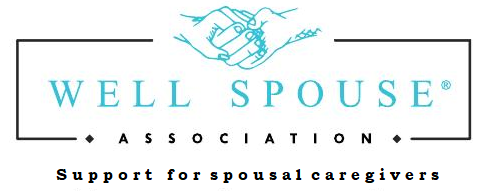Spousal Caregiving at a Glance
There are 47.9 million caregivers of adults 18 and older in the United States(1). Family caregivers provided an estimated $470 billion in uncompensated care in 2017, equating to 14% of all health care expenditures(7). Care recipients may be a parent, child, sibling, spouse/partner, or friend - 12% of those surveyed are caring for a spouse or partner (5.7 million spousal or partner caregivers)(1). Fifty-three percent of spousal caregivers are ages 18-64(2).
The needs of spousal caregivers often differ from those of other family caregivers:
- Our caregiving tends to be higher-intensity than other types of caregiving. It is more medically intensive(4) and we support more ADLs for our care recipients(5). Inequities of care that impact marginalized populations (e.g., race, rural location, language barriers) add even more weight to our responsibilities.
- Spousal caregivers are more likely to perform caregiving without outside help than other caregivers. 66% of spousal caregivers provide care without any unpaid or paid help (versus 29% for other types of caregivers)(1).
- Spousal caregiving may have a longer duration than other caregivers - across all caregivers, 29% have been caregivers for more than 5 years (14% for more than 10 years)(1), but many spousal caregivers provide 24x7 care for years, and 49% of spousal caregivers have cared >3 years(3) – some for decades). When care recipients are younger (ages 18 to 49), care duration is much longer at 7.9 years (on average, significantly longer than the 3.9 years of care provided when caring for someone age 50 or older) (1). As people live longer with chronic illnesses, we expect care duration to increase.
- Our caregiving carries a higher financial cost for our families (and necessarily, our care recipients, given combined finances). Often the patient AND the caregiver must give up paid employment (at the same time that expenses increase due to medical needs). Per NAC/AARP, those caring for a spouse/partner experience 2.4 financial impacts, more than those caring for other relatives or a non-relative (1.3-1.8 impacts) (1).
- Spouses are often excluded from federal, state, and local services and supports available to other caregivers.
- Prolonged caregiving extracts a high price on our physical and mental health, including deeply painful losses of intimacy and companionship in our relationships. In 2020, the proportion of spousal caregivers reporting their health was "excellent" or "very good" was only 32%, and that reflected a decline from NAC/AARP's 2015 report from 45%(1).
The nature of the relationship changes and losses due to caregiving are different for spouses and partners than for other caregivers - the transition to caregiver/patient roles often includes the loss of a singular intimate relationship and its companionship. Spousal caregiving impacts the decision to have children, the way children are raised, and where and how one lives and retires. There are few areas of life that are left untouched by the caregiver/patient role in these relationships.
WSA's mission is to provide resources to spousal caregivers to help them manage their journeys a little more easily.
The Demographics of WSA's Members
WSA has more than 550 current Supporting or Digital Members who are or were caregivers or partners to an ill or disabled partner or spouse as of early 2023. WSA's active Facebook support group includes more than 3,700 members.
As of early 2023:
- Our members have an average tenure of 5 years. Nineteen percent of our members joined more than 10 years ago, and 6% joined more than 20 years ago.
- Women make up 76% of our membership and men make up 24%.
- Eleven percent of our membership is ages 20-50, 11% of our membership is ages 51-65, and the remainder are 66+.
- The top three regions where our members live are the Mid-Atlantic (33%), West Coast (17%), and the Northeast (19%). Three percent of our members live outside the US.
- The top five types of conditions our partners have are:
- Neurological diseases or brain injury (35%)
- Memory-related conditions including dementia (14%)
- Cardiovascular diseases including heart disease and strokes (12%)
- Hematological and solid cancers (8%), and
- Autoimmune diseases. (7%).
- Eighty-three percent of our partners are currently living at home, and 3% live in a facility. Thirteen percent of our members are former well spouses, due to our partners' death or divorce.
Source Data
(1) NAC/AARP’s Caregiving in the US (2020)
(2) University of Pittsburgh. National Rehabilitation Research and Training Center on Family Support (NCFS) Caregiver Profile: A Closer Look at Spousal Caregivers.
(3) AARP Public Policy Institute and United Hospital Fund. "Family Caregivers Providing Complex Chronic Care to Their Spouses." (April 2014)
(4) Per NAC/AARP, those caring for a spouse/partner more often help with medical/nursing tasks (72%) than all other caregivers (56%). Those caring for a spouse/partner are most often in the high-intensity category (59%) of the Level of Care index, more so than those caring for a parent/parent-in-law (35%), other relative (44%), or non-relative (31%).
(5) Per NAC/AARP, those caring for a spouse/partner help with 5.1 out of 7 Instrumental Activities of Daily Living for their care recipients (versus 4.4 IADLs across all caregivers).
(6) AARP Press Room. Family Caregivers Provide $470 Billion in Unpaid Care as Role Becomes More Complicated. (November 2019)
(7) CMS' National Health Expenditure Accounts (NHEA) Data.
Other Research on Caregiving
RAISE Family Caregivers Act - Initial Report to Congress (2021)
AARP Policy Institute report - Valuing the Invaluable: 2011 Update: The Growing Contributions and Costs of Family Caregiving (2011)
Caregiver.com online study - Family Caregivers Face Major Financial Burdens, Increased Stress, and Work Struggles (2011)

Follow us on